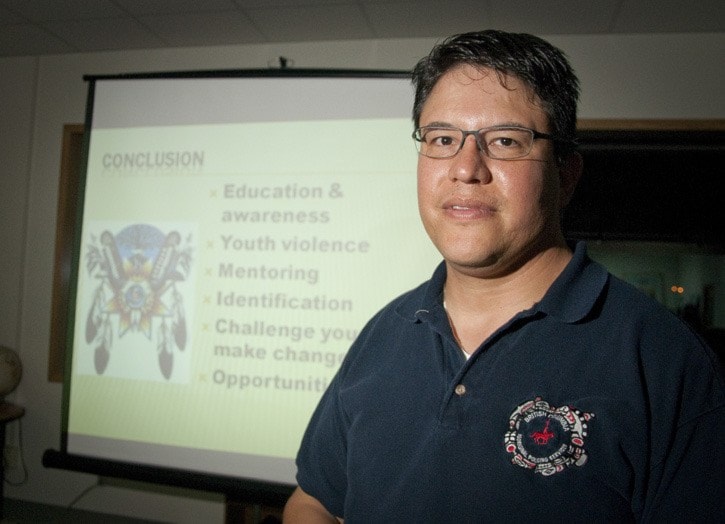Corporal Mike Moyer of the RCMP is taking his talk to communities to educate them about aboriginal gangs.
Moyer put on an in-depth presentation at the high school and one later in the evening at the Enterprise Centre.
The presentation described the distribution of aboriginal gangs across the province, showed photos of some of the various gang hand signs, clothing, and tattoos, explained some of the strategies the gangs are utilizing to recruit young members, some of the risk factors associated with youth who may be drawn into gangs, how members are then initiated into the gangs and some strategies to take to prevent youth from becoming involved in the gang culture.
In Prince George, two of the dominant aboriginal gangs are Indian Posse and Red Alert, which have distinguishable tattoos and graffiti associated with their presence.
According to Moyer’s presentation, aboriginal gangs were brought to western Canada by the transfer of aboriginal gang members to this part of the country by corrections when prisons in Manitoba were seeing such high rates of gang activity and control.
Unfortunately, the movement of gang leaders within the prison system only spread the problem and the leaders then set up new gang cells further west, and these cells have since grown.
The Gang Task Force in the Lower Mainland and higher law enforcement pressure in the area has also since pushed many of the aboriginal gangs out into more rural parts of the province.
Now Moyer said these street-level gangs are moving into relationships with larger organized crime organizations such as the Hells Angels.
Using the First Nations youth to distribute drugs and other illegal activities allows these higher-level organizations easy access to First Nations reserves, where they might otherwise be easily singled out.
Moyer’s presentation explained some of the distinguishing features of the gangs and what to look out for, including specific clothing styles and colours and tattoos along the forearms with gang insignias which distinguish gang enforcers, and can be seen clearly when the person’s fists are raised to fight.
A few of the risk factors Moyer keyed into are the excessive use of video games, which can tend to desensitize youth to violence, and a lack of parental involvement, which the gangs can then manipulate to give the young person a sense of purpose or worth by associating with the gang.
Low-level criminals also can often feel they have no choice but to join a gang in order to survive after being incarcerated, because of the threat and influence gangs pose within the corrections system.
While Moyer warned his audience about the growth of aboriginal gangs, he also urged them to be vigilant about signs which indicated the gang activity in the area has increased or is becoming more prominent such as the graffiti depicting gang symbols like the “R” next to the “A” for Red Alert, and said while it should be removed immediately, photos should also be taken first and shown to the RCMP.
But Moyer in no way suggested enforcement was going to solve the problem.
Instead, Moyer gave suggestions for getting the community involved in preventing at-risk youth from being drawn into the criminal lifestyle.
By creating more non-competitive recreational activities for youth to participate in, by making sure at-risk youth get help if they need it and providing healthy role models for the youth, as well as honest communication with young people, a community can help to prevent the influx of the aboriginal gangs and the increased violence and criminal activity they bring with them.
Moyer said cultural camps and mentoring can help to give youth a positive sense of self-worth so they may not need to go looking to gangs for support and identity.
“I challenge you, leave here and do something,” said Moyer. “It takes a community to deal with this.”
